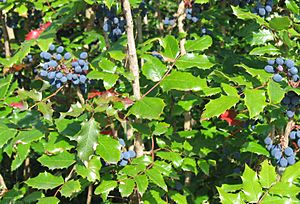Oregon grape facts for kids
Quick facts for kids Oregon grape |
|
|---|---|
 |
|
| Scientific classification | |
| Genus: |
Mahonia
|
| Species: |
aquifolium
|
| Synonyms | |
|
|
The Oregon grape, also known as Mahonia aquifolium, is a beautiful flowering plant. It belongs to the Berberidaceae family. This plant naturally grows in western North America.
It is an evergreen shrub that can grow from 1 to 3 meters (3 to 10 feet) tall. It can also spread out to 1.5 meters (5 feet) wide. Its leaves have spiny leaflets, which look a bit like holly leaves. In early spring, it produces bright yellow flowers. These flowers are followed by dark bluish-black berries.
Contents
What's in a Name?
The scientific name aquifolium means "sharp-leafed". This name refers to the plant's spiny leaves. It's similar to the name of the common holly, Ilex aquifolium.
The common name "Oregon grape" is often used. However, it's not a true grape plant. It gets its name because its berries look a bit like grapes. To avoid confusion, some people call it "Oregon grape-holly" or "Oregon holly-grape".
There are a few different types of Oregon grape. These include the tall Oregon grape (Mahonia aquifolium). Others are the dwarf Oregon grape (M. nervosa) and the creeping Oregon grape (M. repens).
Plant Description
The Oregon grape usually grows about 1 to 2 meters (3 to 7 feet) tall. It can spread up to 1.5 meters (5 feet) wide. Its leaves are long, up to 30 centimeters (12 inches). Each leaf has many spiny leaflets.
The leaves feel leathery and look like those of a holly plant. The stems and twigs of the Oregon grape look thick and corky. In late spring, the plant blooms with dense clusters of yellow flowers. After the flowers, round, dark blue berries appear. These berries are why it's called "Oregon grape."
Where it Grows
The Oregon grape is native to the western parts of North America. You can find it from Southeast Alaska down to Northern California. It also grows from eastern Alberta to central New Mexico.
This plant often grows under taller trees in forests. It is common in Douglas fir forests. You can also find it in brushy areas in the Cascades, Rockies, and northern Sierras mountains. In some places outside its natural home, it can spread too much. It might take over areas where native plants usually grow.
Growing Oregon Grape
Oregon grape is a popular plant for gardens, especially in shady spots. People like it for its interesting leaves and early spring flowers. These flowers often appear before other shrubs bloom.
This plant is tough and can handle dry summers. It also grows well in poor soil. Plus, it doesn't make a lot of leaf litter. Its berries are a good food source for birds.
Many different types and mixes of Oregon grape have been created. Some have even won awards for being great garden plants. Two examples are:
- M. × wagneri 'Pinnacle' (a mix of M. aquifolium and M. pinnata)
- 'Apollo'
How People Use It
The small, purplish-black berries of the Oregon grape are quite tart. They also have large seeds. Native peoples of the Pacific Northwest traditionally ate these berries. They often mixed them with sweeter fruits like salal.
Today, people sometimes use the berries to make jelly. They can be used alone or mixed with salal. You can also make wine from Oregon grape juice. This is similar to how people make wine from barberries in Europe. The berries can even be eaten raw after the first frosts of the season.
The inner bark of the plant's larger stems and roots can be used to make a yellow dye. The berries give a purple dye. Since the leaves look like holly and stay fresh for a long time, florists often use them. They are popular for adding greenery to flower arrangements.
Traditional Uses
Some Indigenous peoples of the Northwest Plateau used Oregon grape in their traditional medicine. They used it to help with indigestion.
Culture
The Oregon grape is the official state flower of Oregon.
Images for kids
-
The yellow flowers grow in clusters 3–8 cm long. Bumblebees and other insects help pollinate the flowers.
See also
 In Spanish: Uva de Oregón para niños
In Spanish: Uva de Oregón para niños



